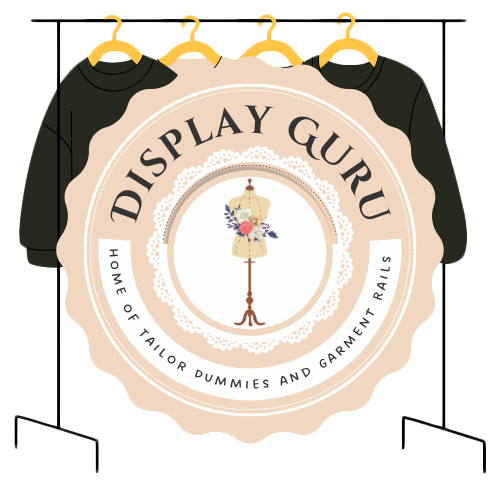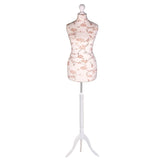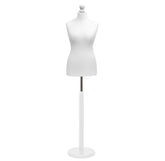Your Guide to Finding the Best Large Clothes Rail
Trying to find the right large clothes rail can feel like a bit of a minefield, but it doesn't have to be. The simple truth is, the 'best' one is the one that fits what you need it to do, day in and day out. Whether you’re kitting out a busy shop floor, organising a stockroom, or building the walk-in wardrobe of your dreams, a few key details will point you to the perfect choice.
This guide will walk you through everything, making that decision a whole lot easier.
Your Complete Guide to Choosing a Large Clothes Rail
A large clothes rail is so much more than a bit of metal to hang clothes on. It's a foundational tool for display, organisation, and efficiency. Think of it as the backbone of your retail space or wardrobe—it has to be strong, reliable, and just the right size for the job. Get it wrong, and you could be dealing with clutter, damaged stock, or a collapsed rail that turns a simple storage solution into a real headache.
On the other hand, the right rail is a genuine asset. It protects your investment in your clothing, makes your daily routine smoother, and can even make your space look better. For a retailer, it's a merchandising workhorse; at home, it’s the secret to a calm, uncluttered wardrobe.
Understanding Your Core Needs First
Before you start looking at steel gauges and castor wheels, let’s take a step back. The first and most important thing is to be crystal clear on what you need your rail to do. Nailing this down from the start makes the whole process simpler and stops you from buying something that just isn't up to the task.
Start by asking yourself a few basic questions:
- What’s its main job? Is it for heavy-duty stockroom storage, an eye-catching display on the shop floor, or a permanent fixture in a bedroom?
- What will it hold? Are you hanging dozens of heavy winter coats, long dresses, or lots of lightweight shirts? The combined weight and length of your garments are crucial.
- Does it need to move? Will the rail stay put, or do you need to wheel it around? This will tell you how important good-quality castors are.
Answering these questions gives you a clear picture of your ideal rail. For example, a stockroom holding stacks of leather jackets needs a static, heavy-duty steel rail built to take some serious weight. A boutique, however, might need a sleek, mobile rail to easily change up its displays. This is also true at home; for smaller rooms or temporary setups, our guide on selecting a portable clothing rack is well worth a read.
When you match the rail's features—its material, how much it can hold, and whether it can move—to your specific needs, you're setting yourself up for success. It’s the difference between a rail that just ‘does the job’ and one that’s a perfect fit.
Comparing the Different Types of Clothes Rails
Choosing a large clothes rail isn't a one-size-fits-all decision; the best choice really depends on what you need it to do. Think of it like picking a vehicle. A static, heavy-duty rail is the dependable lorry of the storage world—unmoving, incredibly strong, and built for the maximum possible load in a stockroom. A wheeled, adjustable rail, on the other hand, is more like a nimble delivery van, perfect for navigating a dynamic shop floor or a busy creative studio.
Getting to grips with the different styles is the key to finding your perfect match. Each type is designed with a specific job in mind, offering its own unique blend of strength, mobility, and display potential. Let's break down the most common options to see how they stack up.
The Classic Single Rail
The single rail is probably the style you picture first—it's a true workhorse. Its straightforward design, a single horizontal bar held up by two legs, is all about simplicity and strength. This is your go-to option for creating clear, linear storage and uncluttered displays.
- Ideal Application: Perfect for stockrooms where you need easy access, for minimalist retail displays, or as a seriously robust solution for a walk-in wardrobe at home.
- Core Advantage: Its simple construction often translates to a very high weight capacity, making it a brilliant choice for heavy garments like winter coats or piles of denim.
- Potential Limitation: It offers the least storage density. If your floor space is at a premium, a single rail might not be the most efficient choice.
This infographic breaks down the core decisions you'll face, focusing on material, capacity, and size.
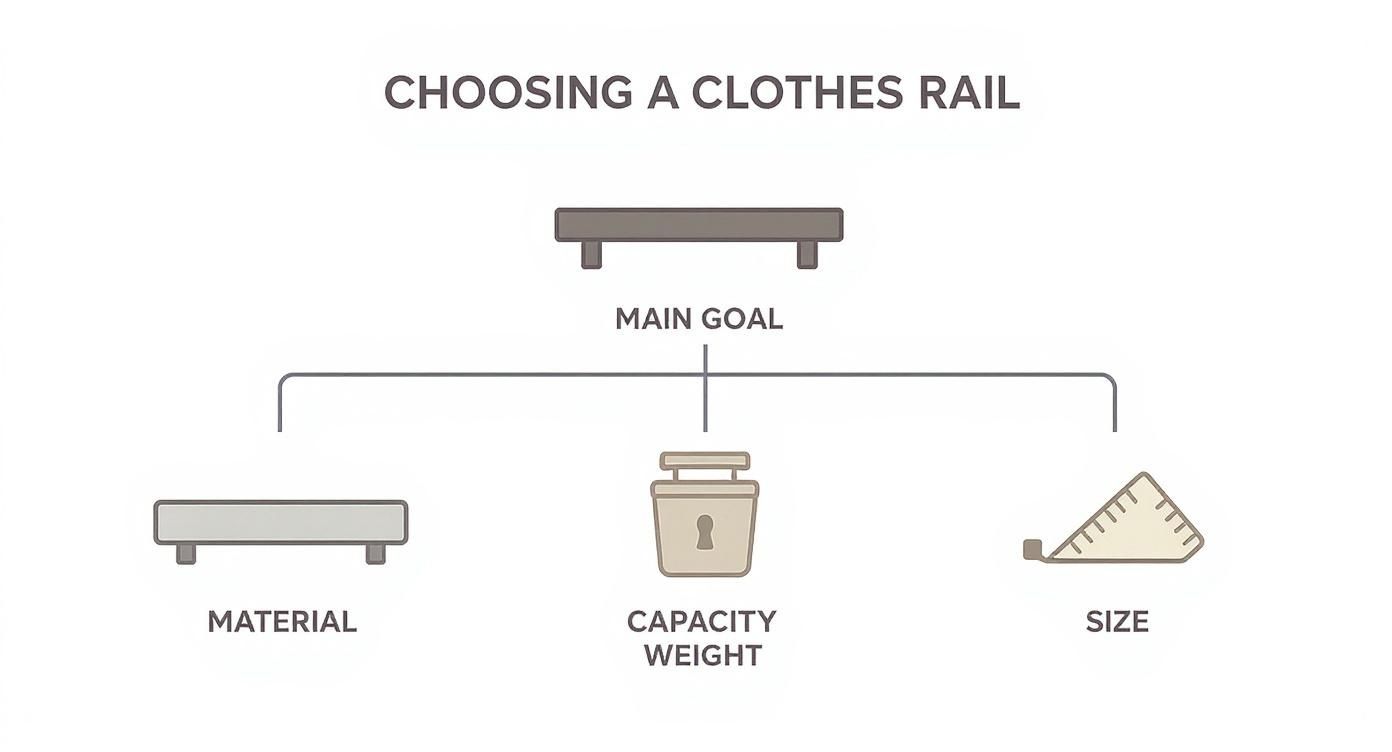
As the diagram shows, what you need the rail for directly influences the physical features you should look for, from the durability of the steel right down to the overall dimensions.
The Space-Saving Double Rail
When you need to get the most out of your vertical space without taking up a larger footprint, the double rail is an excellent solution. By adding a second parallel or staggered rail, it can effectively double your hanging capacity in the same amount of floor space.
Many double rails are designed with one bar higher than the other, which is perfect for organising different types of clothing. You could hang longer items like dresses on the top rail, for instance, and shorter pieces like shirts or folded trousers on the bottom. This tiered approach is a smart way to stop garments from dragging on the floor and makes browsing much easier for customers.
The Boutique-Style Multi-Arm Rail
To create dynamic and engaging visual displays, the multi-arm or 'waterfall' rail is a merchandiser’s best friend. Instead of a single straight bar, it has multiple, often cascading, arms that extend from a central post. This lets you showcase individual items or group small collections together brilliantly.
The real power of a multi-arm rail is its ability to break up the visual monotony of a long, straight line of clothing. It encourages customers to engage with specific products, making it a powerful tool for highlighting new arrivals or featured items.
This style is less about bulk storage and more about curated presentation. It's the ideal choice for creating focal points within a retail space, drawing a customer's eye exactly where you want it.
The Industrial Z-Frame Rail
Prized in industrial settings like warehouses, commercial laundries, and the backrooms of fashion shows, the Z-frame rail is the undisputed champion of strength and clever storage. Its name comes from the distinctive Z-shape of its base, a design that isn't just for looks.
This clever bit of engineering allows multiple rails to "nest" together when they're not in use, drastically cutting down the amount of floor space they occupy. A single Z-frame rail can often hold over 150kg, thanks to its robust, all-metal construction. For any business that needs to move large volumes of garments efficiently, the combination of high capacity and space-saving nesting makes the Z-frame an invaluable asset.
To help you see the options at a glance, we've put together a simple comparison table.
Large Clothes Rail Type Comparison
| Rail Type | Primary Use Case | Typical Capacity | Key Feature |
|---|---|---|---|
| Single Rail | Stockrooms, minimalist retail, home wardrobes | High to very high | Simple, strong, and provides easy access to all items. |
| Double Rail | Retail floors, small stockrooms, maximising space | Very high | Doubles hanging capacity within the same footprint. |
| Multi-Arm Rail | Boutique displays, highlighting featured products | Low to medium | Creates visual interest and showcases individual items. |
| Z-Frame Rail | Warehouses, events, commercial back-of-house | Extremely high | Nests together for compact storage when not in use. |
This table should serve as a quick reference, but remember that the "best" rail is always the one that solves your specific storage or display problem most effectively.
Getting to Grips with Rail Materials and Build Quality
When you’re choosing a large clothes rail, you’re not just buying a piece of metal; you're making an investment. It’s the difference between a temporary solution and a reliable fixture that lasts for years. While many rails might look the same from a distance, the real markers of quality and durability are hidden in the details of their construction.
The best rails on the market are almost always crafted from industrial-grade steel. But not all steel is created equal. The finish applied to the steel plays a massive role in both how the rail looks and how well it stands up to the rigours of daily use.
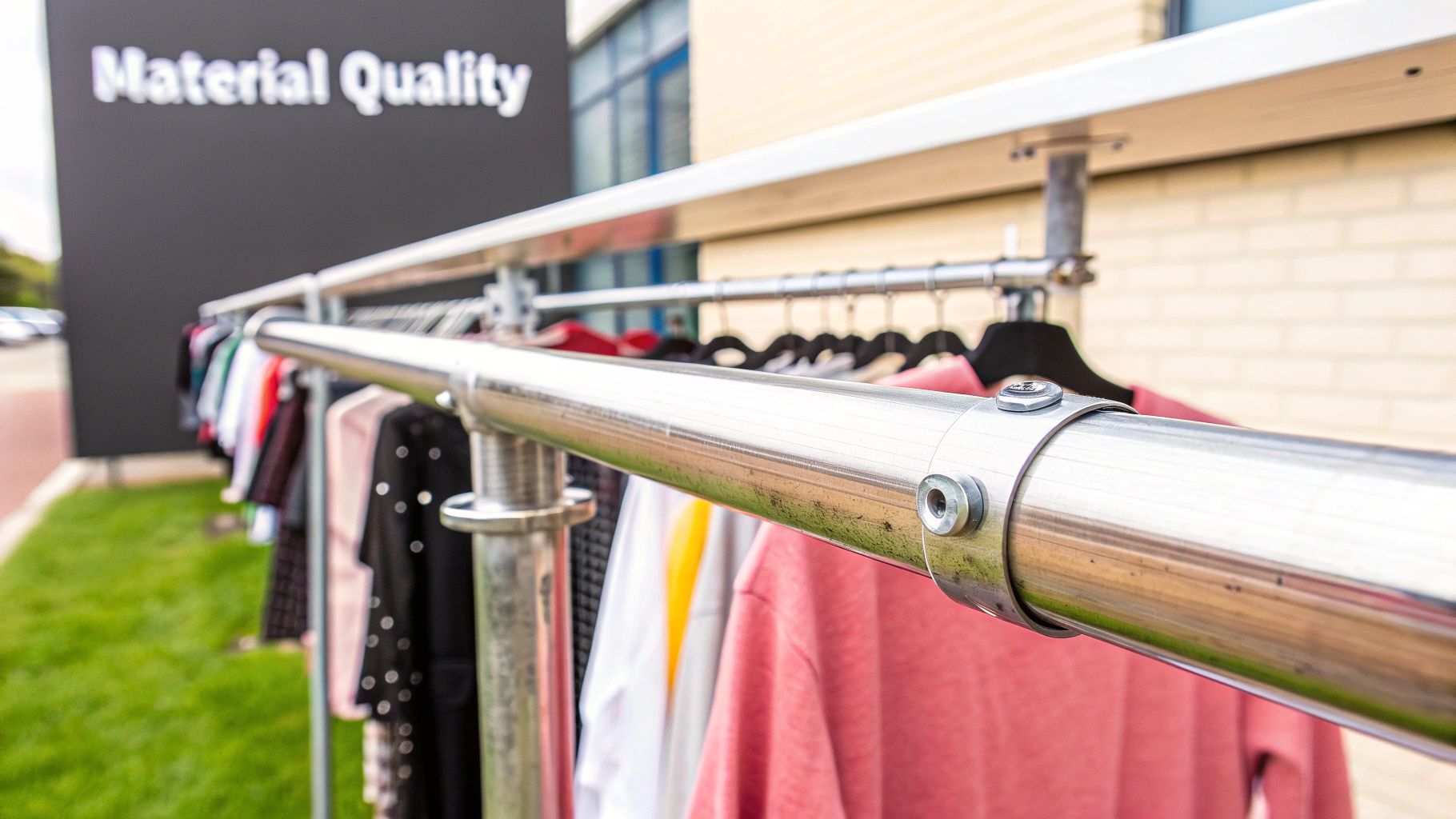
Finishes That Really Perform
In the professional world, two finishes stand out from the crowd: powder-coating and chrome plating. They've earned their reputation by delivering a smart blend of visual appeal and rugged performance.
- Powder-Coated Steel: This finish, most often seen in black or white, is the champion of durability. It creates a tough, protective layer that’s brilliant at shrugging off the inevitable scuffs, chips, and scratches of a busy shop floor or stockroom. It’s a true workhorse.
- Chrome-Plated Steel: If you’re aiming for a more classic, premium aesthetic, chrome is the way to go. Its bright, reflective surface can instantly elevate a boutique display, adding a touch of sophistication while providing solid protection against corrosion.
The choice of finish really comes down to balancing style with substance. A powder-coated rail is a modern, practical powerhouse, while a chrome rail offers timeless elegance. Both are built to last, but they shine in different settings.
Look Deeper Than the Surface
A good finish is important, but what truly defines a rail's strength is what’s going on underneath. It’s the small construction details that give a large clothes rail its backbone and stability. To properly judge a rail, you need to look for the tell-tale signs of quality engineering.
Start by examining the welds at the joints. A top-quality rail will have solid, continuous steel welds that fuse the components into a single, unyielding structure. This is worlds away from rails that are spot-welded or, worse, held together with flimsy plastic connectors that are almost guaranteed to fail over time. For a more detailed look at what makes a rail genuinely tough, check out our complete guide to strong clothing rails.
The Anatomy of a Strong Rail
Besides the welding, two other elements are absolutely vital for a rail’s longevity: the tube diameter and the quality of the fixings. A thicker tube simply has a higher load capacity, which stops the rail from sagging under the weight of heavy stock like winter coats or piles of denim.
Likewise, always look for industrial-grade metal fixings and bolts. Cheaper rails often cut corners by using plastic parts for key structural connections. These components can go brittle and crack under load, compromising the safety and integrity of the whole unit. A rail that is steel through-and-through, from the frame right down to the nuts and bolts, is a much smarter and safer choice for any professional or demanding home environment.
Calculating Space Needs and Load Capacity
There are two details that will absolutely make or break your experience with a large clothes rail: getting the dimensions right and truly understanding its weight limit. Get either of these wrong, and you could end up with a rail that simply doesn't fit your space or, much worse, one that buckles under the pressure. A careful, methodical approach isn't just a good idea—it's essential for a smart, long-term investment.
Before diving into the numbers for your rail, it’s worth taking a step back to consider the bigger picture of what is space planning. Thinking like a designer helps you map out the entire area, not just the rail's footprint, ensuring you create a layout that feels both functional and easy to move around in.
Measuring Your Space with Precision
The first job is to measure the physical spot where your rail will live. But here’s where many people go wrong: just measuring the floor space isn't enough. You have to account for two crucial "buffer zones" to make sure the rail is actually practical and doesn't turn the area into an obstacle course.
Think of it like parking a car. You don't just need a space the exact size of your vehicle; you need room to open the doors. A clothes rail works on the same principle.
- Garment Overhang: Standard clothes hangers are about 40-45cm wide. That means your clothes will stick out around 20-22cm from the centre of the rail on each side. If you're placing the rail against a wall, you absolutely need at least that much clearance to stop garments from getting squashed or snagged.
- Walkway Clearance: Whether it's for a busy retail floor or a stockroom, you need a clear path for people to walk. A comfortable walkway is generally between 75-90cm wide. Always build this into your measurements to keep the space safe and accessible.
Demystifying Load Capacity
Load capacity is often the most misunderstood specification, yet it's the most critical for safety and durability. You'll often see figures like "150kg UDL" thrown around, which can feel a bit abstract. The key is understanding what UDL means.
UDL stands for Uniformly Distributed Load. This simply means the weight must be spread evenly across the entire length of the rail, not all piled up in one spot. Concentrating all your heavy winter coats at one end is a recipe for disaster, even if you’re technically under the total weight limit.
To bring these numbers to life, let’s translate them into something more tangible. Knowing what a rail can actually hold helps you visualise its true strength.
Load Capacity in Practice
| Weight Capacity | Example Garment Load (Approximate) | Best Use Case |
|---|---|---|
| 75kg | 70-80 T-shirts or 35 heavy jackets | Home use, pop-up shops, light retail |
| 120kg | 120 blouses or 50 winter coats | Busy retail floors, small stockrooms |
| 150kg+ | Over 150 shirts or 60+ heavy coats | Industrial stockrooms, warehouses |
This kind of practical comparison helps you avoid the all-too-common mistake of overloading. Choosing the right capacity isn't guesswork; it's about matching the rail's strength to the real-world weight of your stock. For a much deeper dive into what makes a rail genuinely robust, our complete guide to heavy-duty hanging rails is an invaluable resource.
The Impact of a Growing Market
The need for reliable, high-capacity storage is more important now than ever. The UK clothing retail industry has seen impressive growth, expanding at a compound annual rate of 5.2% over the past five years and is projected to hit an estimated £50.0 billion in 2025.
This boom puts even more pressure on retailers to have storage systems that can handle ever-increasing stock levels safely and efficiently. It turns a simple load capacity calculation from a technical detail into a vital business decision.
Merchandising Tips for Retail and Studio Use
A large clothes rail is so much more than just a place to hang clothes. In the right hands, it’s a powerful tool for telling a visual story and streamlining your day-to-day operations. For a retailer, it’s your silent salesperson, guiding customers through a carefully curated journey. For a creative professional, it’s the backbone of an organised, productive workflow.
Think of your rail as a stage for your products, not just a storage rack. Instead of simply hanging items, focus on creating a narrative. You could group garments to tell a story—maybe a complete outfit for a weekend getaway, a capsule wardrobe for the office, or a collection of pieces all in this season's must-have colour.
This simple shift in perspective turns a passive browser into an engaged shopper by showing them not just what to buy, but how to wear it. It moves the conversation from individual items to inspirational looks, a far more compelling way to sell.

Creating Visual Impact in Retail
On a busy shop floor, your large clothes rail needs to command attention. One of the most effective and simplest ways to do this is with colour-blocking. By grouping items in solid blocks of complementary or contrasting colours, you create a powerful visual rhythm that’s both easy on the eye and simple for customers to navigate.
Another smart tactic is to use your rail to create a focal point. Position a rail right at the entrance or at the end of an aisle, and load it up with your most exciting new arrivals or a high-margin collection. This immediately draws customers deeper into your space and signals what’s new and important.
A well-merchandised clothes rail doesn’t just display products; it creates desire. It guides the customer's journey, answers unasked questions about style, and makes the shopping experience feel effortless and inspiring.
This kind of visual strategy is more important than ever. With UK online fashion sales projected to hit £21.01 billion in 2025, the line between physical and digital retail is blurring. A key part of this is social commerce, which is set to more than double from £7.4 billion in 2024 to £16 billion by 2028. Creating 'shoppable' moments in your store with beautifully styled rails gives you perfect content for social media, bridging the gap between an in-person visit and an online purchase.
For more foundational techniques, our comprehensive visual merchandising guidelines will help you build a strong base for all your displays.
Organising a Creative Studio Workflow
In a photography studio, a tailor’s workshop, or a stylist’s prep area, a large clothes rail serves a completely different—but equally critical—purpose: efficiency. In these fast-paced environments, organisation is everything. Using multiple rails allows for a systematic, almost assembly-line approach to managing garments.
Try dedicating separate rails for each stage of a project:
- Rail 1: The 'Incoming' Rail: This is where all garments land when they first arrive for a shoot or fitting.
- Rail 2: The 'Styled Looks' Rail: Use this rail to assemble complete, pre-approved outfits, right down to the accessories.
- Rail 3: The 'Returns/Alterations' Rail: After being used, items are moved here to be prepped for sending back or marked for alterations.
This system puts an end to the chaos, protects clothing from damage, and saves precious time during high-pressure shoots or fittings. It transforms a humble piece of equipment into the cornerstone of a highly organised and professional creative operation.
Getting It Right: Assembly and Long-Term Care
https://www.youtube.com/embed/SC8IqlKhcFI
A heavy-duty clothes rail is a real workhorse, built to last you years. But like any good piece of equipment, its lifespan really comes down to getting the assembly right from day one and looking after it properly. Taking a few extra minutes during the setup will save you a world of headaches later and ensure your rail is safe, stable, and ready for action.
Most professional-grade rails are designed for a straightforward build, often using a simple click-lock mechanism or basic screws. It's tempting to rush, but one of the most common mistakes we see is people over-tightening the fittings. Cranking down too hard can strip the threads, which weakens the entire joint. Just tighten everything by hand until it’s snug and firm; there's no need to force it.
Another quick but crucial step is fitting the castors. Make sure they are pushed all the way in and properly locked into the frame, just as the instructions show. A wobbly rail is almost always down to a poorly fitted castor, and that's a real hazard when you've got it loaded up with heavy stock.
A Simple Maintenance Routine is Your Best Friend
Once your rail is up and running, a little bit of upkeep is all it takes to keep it in prime condition. A simple, regular check-up protects the finish, maintains its structural strength, and keeps it looking smart for customers. Think of it as a quick MOT for your display equipment.
How you clean your rail depends entirely on its finish. Each one needs a slightly different touch to keep it looking its best.
- Powder-Coated Rails (Black/White): A soft, damp cloth with a bit of mild soap is all you need here. This finish is tough as nails, but harsh chemicals or abrasive cleaners can eventually dull the matte look.
- Chrome Rails: For a chrome finish, a microfibre cloth is your go-to. A quick wipe with a dry one will often get rid of fingerprints. If it needs a bit more of a clean, a little glass cleaner will bring back that brilliant shine.
This isn’t just about looks. Regular cleaning stops dust and grime from building up in the moving parts, keeping everything running smoothly.
A proactive approach is always better than a reactive one. A quick five-minute check each month can stop small issues from turning into big problems, making sure your rail remains a safe and reliable asset for your business.
Don't Forget Regular Structural Checks
Beyond a quick clean, it pays to do a periodic structural check, especially if your rail is in a busy shop or a hectic stockroom. These things are under constant stress, and over time, fittings can work themselves loose. It only takes a minute.
Once a month, just give the main joints and connection points a quick inspection. Gently check if anything feels loose and tighten it up if needed. Pay close attention to the castors—are they still securely in place? Do they roll freely? If a wheel feels stiff, it’s probably just a bit of thread or debris caught in the mechanism.
This simple routine is the key to maintaining your rail's stability and preventing any nasty surprises. For more tips on matching the right parts, our guide on choosing the right clothes rail and brackets is a great resource. A little care goes a long way in protecting both your garments and your investment.
Common Questions About Large Clothes Rails
Even when you think you’ve got all the details sorted, a few last-minute questions always seem to pop up. It's completely normal. Answering these common queries is often the final step to feeling confident you're choosing the right rail for your space. We get asked these all the time, so here are some straight-talking answers to help you out.
What Is the Best Way to Prevent a Clothes Rail from Tipping Over?
The secret to a stable rail is all about balance. Think of it like loading a set of scales – you wouldn't put all the weight on one side. Avoid hanging all your heavy items, like winter coats or a pile of denim, at one end. Spreading the load evenly is the single best thing you can do to keep it upright and secure.
If your rail has wheels, get into the habit of locking the castors once it's in position. But the golden rule is this: never exceed the manufacturer's stated load capacity. Overloading is the number one reason rails become unstable, tip over, or even break.
Can I Use a Commercial Grade Clothes Rail at Home?
Absolutely! In fact, it's often a much smarter choice. Commercial-grade rails are built to a completely different standard than what you'd typically find for home use. They're made with thicker steel and stronger welds because they have to survive the constant use and abuse of a busy shop floor.
This built-in toughness makes them a brilliant long-term investment for a walk-in wardrobe, a busy laundry room, or for anyone who simply has a serious amount of clothes. While a domestic rail might start to sag or wobble over time, a commercial one will give you lasting performance and total peace of mind.
How Do I Choose Between a Black, White, or Chrome Finish?
Your choice of finish really comes down to a mix of personal taste and practical need. A classic chrome finish gives you that timeless, mirror-like shine. It looks fantastic in high-end boutiques or stylish home interiors and adds a real touch of elegance.
Powder-coated finishes, which usually come in black or white, offer a more modern, matte look.
But there's more to it than just aesthetics. A powder-coated surface is incredibly durable and far more resistant to the chips and scratches that come with daily life. This makes it the go-to choice for high-traffic areas like stockrooms or bustling shop floors.
Are Heavier Clothes Rails Always Better?
Not necessarily. It's a common misconception that heavier means stronger. While a bit of heft can suggest solid materials, the real markers of a quality rail are its build quality and engineering design. A well-designed rail, made from high-grade, thick-gauge steel with clean, solid welds, can actually be lighter but far stronger than a clunky, heavy one that's been poorly put together.
So, instead of judging a rail on its weight, look closer at the details. Check the official load capacity and inspect the quality of the construction, paying attention to the welds and fixings. That’s where you'll find the true measure of its strength.
At Display Guru, we provide professional-grade rails designed for durability and performance. Explore our complete collection of large clothes rails and find the perfect solution for your retail space, studio, or home.
